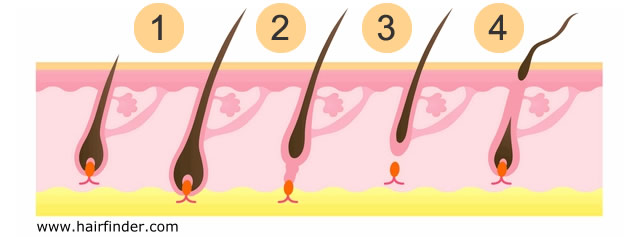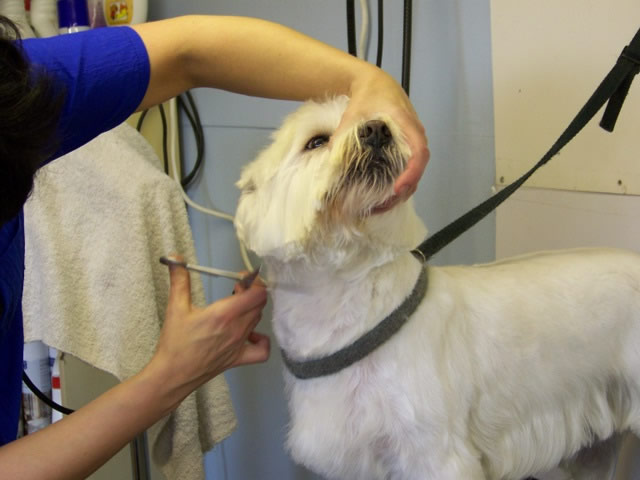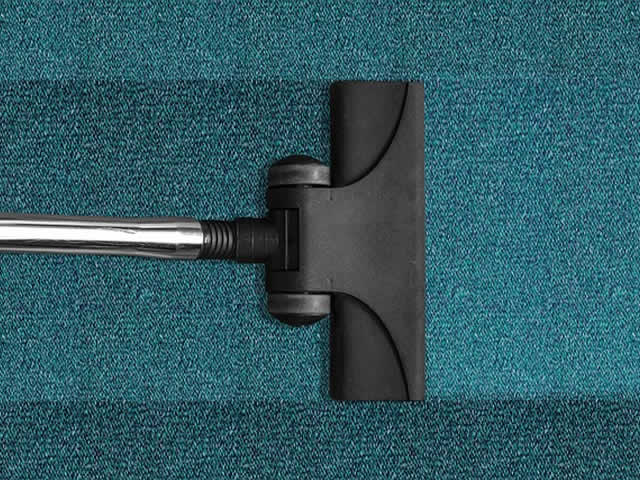How To Get Dog Hair Off Of Clothes
Dogs have hair… It's one of the reasons we love them. What most people don't love is balls of puppy fluff stuck to their work suit before a meeting or their skirt before a dinner date. Knowing how to get dog hair off clothes will make living with your dog much more pleasant, because the hair will be where it belongs (on the dog) and not on you!
Why do dogs shed?
All animals with hair (even us!) shed hair on a regular basis. Each hair grows, stops growing and is shed. The length of time between hairs growing to falling out varies between dogs.
The diagram below depicts the canine hair cycle.

Your dog's hair grows in a four stage cycle:
- The Anagen phase
- The Catogen phase
- The Telogen phase
- The Exogen phase
During this phase your dog's hair grows quickly until it reaches it desired genetic length. In short haired breeds the Anagen cycle is fairly brief whereas long haired breeds such as Yorkshire Terriers have a longer Anagen phase.
Breeds like Poodles (and others that need regular haircuts) have a predominantly Anagen hair cycle similar to humans. This is why they do not shed as much.
Once the hair has reached its desired genetic length, the growing process slows. The hair follicle contracts and detaches from the dermal papilla, which is where it gets nutrients from.
This is the resting phase where the hair does not receive nutrients. The hair however, is still anchored to the skin.
Dogs that don't need regular haircuts have a telogen-predominant hair cycle where the hair remains in this phase until it is shed from their skin.
This is the shedding phase where the hair falls out and the follicle returns to the growing phase again. The hairs that you find on your clothes have been expelled during the exogen phase.
IMPORTANT NOTE: This cycle depicts the normal hair cycle of a dog where old hairs are replaced with new hairs after they have shed. If your dog is shedding rapidly and hair is not reforming they are suffering from hair loss (Alopecia). This can be due to a number of reasons including genetics, poor diet, illness, dermatitis or mites. If your dog's hair is getting progressively thinner and you notice bald spots, you should take them to your vet to get checked out.
When do dogs shed?
They shed twice a year – once in Spring and once in Autumn, right? No! This is not necessarily true. Due to their lifestyle change in society,dogs now tend to shed all year round.
Once upon a time dogs shed in periodic cycles just like wolves. They had a natural rhythm influenced by the length of days and the rising and falling of the sun. In Spring they would shed their thick coats in time for the warmer weather and then in fall would get rid of their lighter undercoat in time to replace it with a thick coat for winter.
Blurred lines
The lines between these distinct shedding periods have blurred because of domestication and the fact that more dogs (and cats) than ever are classified as 'indoor pets' – 80% in 2010 vs 63% in 2000. That's a lot of pet hair and no doubt in 2014 these number have increased again!
Distinct shedding phases occurred when the hair cycle and individual phases of hairs (mentioned above) occurred at the same time. Nearly all of the hairs went through the Anagen, Catogen, Telogen and Exogen phase at this same time.
The modern dog's hair cycle, however, is all messed up. They lost their rhythm and different hairs are now shed at different times during the year: Most of them ending up on your floor, furniture and of course your clothes!

Spring and Autumn Shedding
The bad news for you is that whilst your dog will shed all year round – they shed even more in Spring and Autumn! Each dog has still somewhat retained the shedding rhythm of their ancestors and will often 'blow their' coat based on seasons.
Veterinarian Dr. Ron Hines, reveals that Nordic dog breeds (Husky, Japanese Spitz, Chow Chow etc.) have kept the wild shedding pattern the best, out of all dogs. They tend to do the majority of their shedding once or twice a year, seasonally.
Prevention is better than cure
Dog hair has this amazing ability to embed itself into the very fibres of your clothes. If you are losing the war against dog fur, it may be time to begin defending your wardrobe a little better. Once the hair has made its way onto your favourite jumper, it's a lot of effort to get it off. The best thing you can do is spend sometime preventing it from getting there in the first place.
Prevention focusing on the Dog

Image courtesy of Miss Steel - Geograph.co.uk
Choose dog breeds that are less prone to shedding
Some dogs actually shed less so bringing home a furry friend that belongs to a certain breed could reduce the number of pet hairs found on your clothes. Of course, if you've been picking hairs of your sleeve for years – it's already too late!
Dog breeds that shed the least include:
- Poodle (and Oodles)
- Bichon Frise
- Chinese Crested
- Staffordshire Bull Terrier
- Greyhound
- Yorkshire Terrier
- Maltese
If looking for a mixed breed dog that sheds less try to find out if they have any of the breeds listed above in their genetics or look for a dog with wavy 'fleece' like hair like many Poodle mixes.
Groom your dog regularly
Depending on your dog's coat, you may get your pooch professionally groomed or DIY at home. For the pros and cons of each optionand how to groom different types of coats read our previous article here. Whatever option you choose regular grooming will help reduce the amount of hair that you find on your clothes.
A good bath with a specific dog shampoo will help wash away loose hairs. Also, using a dog conditioner will help to keep skin moisturised and stop your dog from scratching and nibbling away at dry skin.
Brushing or combing fur will help in three ways:
- Brushing helps to remove loose undercoat hairs that are trapped under the topcoat.
- Brushing and combing helps to gently remove dead hair that is about to fall out.
- It helps to disperse healthy oils throughout your dog's fur and skin resulting in healthy, stronger hair and nourished skin.
One of the most popular de-shedding tools we have is the Furminator. It has a tool designed for small, medium and large longhair/shorthair dogs, so there is one appropriate for every dog. The Furminator and other de-shedding tools should ideally be used on double coated dogs, since these tools remove loose undercoat hairs.
Feed them a good diet
Diet plays a part in the amount your dog sheds. This is because a balanced diet produces healthy hair and skin. Feeding food rich in omega 3 and 6 fatty acids will stop your dog's skin from becoming dry and will prevent brittle hair.
Poor diet and low Omega 3 cause increased shedding as the dog's body will actually pump toxins into dying hair strands as a removal technique. While Vets All Natural Skin and Coat Formula won't stop normal seasonal shedding, it can assist with this type of dry coat shedding. In this case you may want to supplement with a skin and coat formula.
Teach your dog good manners
If you want to avoid hair on your clothes then one of the simplest things you can do is teach your dog not to jump on you! Watch Tony Knight's video below for tips on teaching your dog not to jump up.
Tony Knight shares his tips on teaching your dog not to jump up.
Prevention focusing on the Home

Vacuum your home often
In the war against dog hair, the vacuum is your best ally. Regular vacuuming will ensure that stray dog hairs are scooped up before they have a chance to get to your clothes. Not all vacuum cleaners were created equal so look for a vacuum that is specifically designed to pick up pet hair. Don't just take the manufacturer's word for it either – Make sure to read plenty of online reviews from pet-parents that have put it to the test.
Suction will suffer if the bag or dust compartment isn't emptied, so dump out the dust and hair after each session. You'll also want to ensure that you pull clumped up dog hair out of the vacuum wand and agitator brushes on a regular basis.
There's no set time frame for vacuuming your house but most people commit to cleaning their house on a weekly basis. Depending on how many shedding dogs you have and how many dinner parties you hold, you may want to vacuum more or less frequently.
Wash dog bedding
Imagine if you slept in your bed for months on end and never washed your bedding? It would be gross, right? Just like you wash your sheets and doona cover, dog bedding should be washed regularly too.
The dog bed doesn't need to be washed every week but once a month is a good idea. It will help to keep your home smelling fresh and will reduce the number of pet hairs lying around. Your dog bed probably came with washing instructions so refer to them before cleaning your bed.
Most of the time dog beds are machine washable in order to be easy to keep clean. If it is machine washable follow these steps:
- Brush off most of the dog hair.
- Pop the bed on a cool/warm wash using a mild detergent.
- You can then put it in the dryer (if suitable material) or air dry.
If you have a bed large enough for a Great Dane, it probably won't fit in your washing machine. In this case, fill your bathtub with warm water and hand wash it using a mild detergent.
Keep washing machine clean
Washing dog beds, blankets and clothes covered in hair can cause your washing machine and dryer to get a little clogged up. This makes them less effective at removing hair, which is the last thing you want!
After washing items like dog beds and other extra hairy items, run a rinse cycle to make sure all the hairs are washed out of the pipes and down the drain. Each time you use your dryer empty out the lint catcher to keep it working efficiently.
Top 3 methods of removing dog hair from clothes
Even if you implement every single one of the tips above; it's inevitable that you'll get hair on your clothing! When this happens use one of these three methods on how to get dog hair off clothes:
- Use a good lint roller
- Damp hands or damp rubber gloves
- Wet hands and shake off excess water.
- Wipe your hands across your clothes using a downward motion.
- As the hair begins to ball up, pick it off your clothes and dispose of in a rubbish bin.
- Add vinegar to your wash
Anyone that thinks lint rollers don't work must have never owned a good one. Two dollar store rollers will break and you'll have to fight to remove the used adhesive strips. On the other hand,investing in a good lint roller will save you time and energy. Look for a refillable heavy duty one such as the Aussie Lint Roller.
Dr.Rod from Toorak Village Vet explains how to effectively use a lint roller.
Using moisture can help to remove hair from clothes as it weighs down the fur and causes it to bunch together. This method works either with bare hands or whilst wearing a pair of rubber cleaning gloves:
As a handy tip: Adding ½ cup of white distilled vinegar to the washing machine rinse cycle helps to stop dog hair from clinging to your clothes. It reduces static electricity in fabrics so that pet hair and other lint doesn't stick to it.
How To Get Dog Hair Off Of Clothes
Source: https://www.mypetwarehouse.com.au/my-pet-blog/pet-care/dog/how-to-get-dog-hair-off-clothes
Posted by: blacktheressuard.blogspot.com

0 Response to "How To Get Dog Hair Off Of Clothes"
Post a Comment